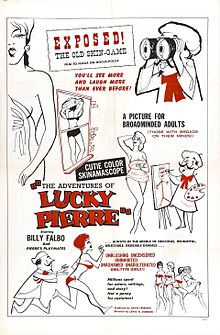The Adventures of Lucky Pierre
| The Adventures of Lucky Pierre | |
|---|---|
 | |
| Directed by | Herschell Gordon Lewis (credited as Lewis H. Gordon) |
| Starring | Billy Falbo Lawrence J. Aberwood (as Lawrence Wood) William Kerwin |
| Cinematography | Herschell Gordon Lewis |
| Music by | Herschell Gordon Lewis Larry Wellington[1] |
Production company | Lucky Pierre Enterprises |
| Distributed by | Something Weird Video |
Release date |
|
Running time | 60 minutes |
| Country | United States |
| Language | English |
| Budget | US $7,500[2] |
The Adventures of Lucky Pierre is a 1961 nudie cutie film created by exploitation filmmakers Herschell Gordon Lewis and David F. Friedman. The first of its kind to be filmed in color,[3] the film starred comedian Billy Falbo. It was unique for its time and genre, adding successful comedy to the nudity and sensationalist material.
History
[edit]The film was conceived by Lewis and Friedman when film distributor Alfred N. Sack offered the two $7,000 to create a single-reel, "color 35mm film of cute girls carousing around with beach balls, or whatever."[4] Upon learning of this reel, another distributor offered a deal to expand the film into a full-length feature film. The two spent around five hours writing the film,[5] and, with Falbo, proceeded to film the movie over a four-day period in Chicago, Illinois.[4]
Plot
[edit]The Adventures of Lucky Pierre is a series of vignettes featuring the title character, Lucky Pierre, in a series of unrelated storylines involving scantly-clad or nude women.[6] Pierre, named after a childhood rhyme Friedman and Lewis remembered, would end up in a short segment where he encounters various naked women – for instance, in "Drive-In Me Crazy", Pierre attends a drive-in movie where the ticket taker and concession workers are all nude women who also appear in the film he's seeing.[7] In another, Pierre, as a painter, has three nude women posing for him in a park,[8] and another vignette had Pierre come upon two sunbathing women while birdwatching.[9]
Reception
[edit]The film was a financial success, grossing over $12,000 in a single theater over a week's run upon opening,[10] and continued to enjoy financial success while avoiding the type of censorship previous exploitation films such as Mom and Dad faced.[11] The film ushered in a new form of sexploitation film, the "nudie cutie", and Friedman, who worked with the American Film Institute to catalog such films for them,[6] estimated over 600 Pierre-style films were released between 1961 and 1970.[12]
References
[edit]Notes
[edit]- DVD Talk: "CineSchlock-O-Rama: Herschell Gordon Lewis: The Godfather of Gore." G. Noel Gross, 27 April 2001. URL accessed 28 May 2007.
- David F. Friedman, A Youth in Babylon: Confessions of a Trash-Film King (Buffalo, N.Y.: Prometheus Books, 1990; ISBN 0-87975-608-X).
- Internet Movie Database: The Adventures of Lucky Pierre. URL accessed 28 May 2007.
- New York Times: "I Lost It at the Movies." Will Blythe, 1 December 2002. URL accessed 28 May 2007.
- Pitchfork Media: L. Pierre - Dip review. URL accessed 28 May 2007.
- Mike Quarles, Down and Dirty: Hollywood's Exploitation Filmmakers and Their Movies (Jefferson, North Carolina, McFarland, 2001; ISBN 0-7864-1142-2).
- Reel.com: "David F. Friedman: Wage Earner of Sin." URL accessed 28 May 2007.
- Adam Rockoff, Going to Pieces: The Rise and Fall of the Slasher Film, 1978-1986. (McFarland & Company; 2002; ISBN 0-7864-1227-5).
- Something Weird Video: The Adventures of Lucky Pierre. URL accessed 28 May 2007.
